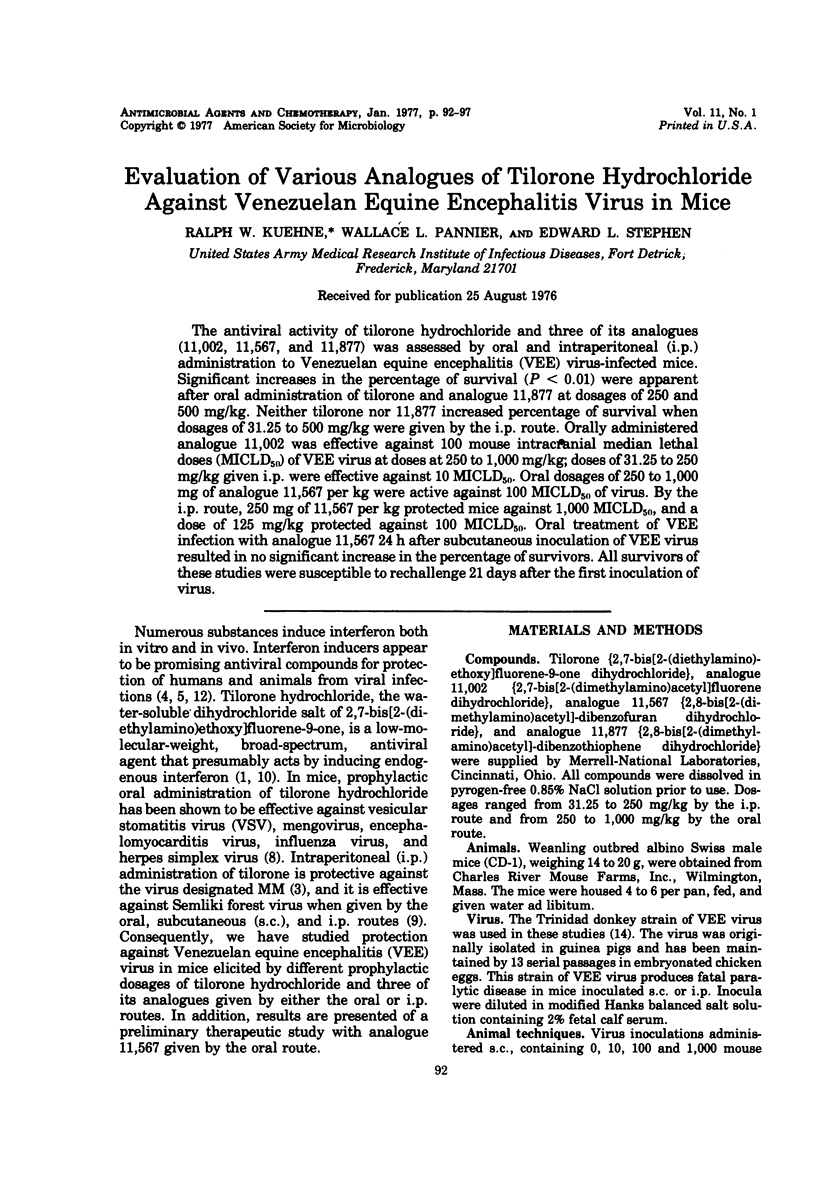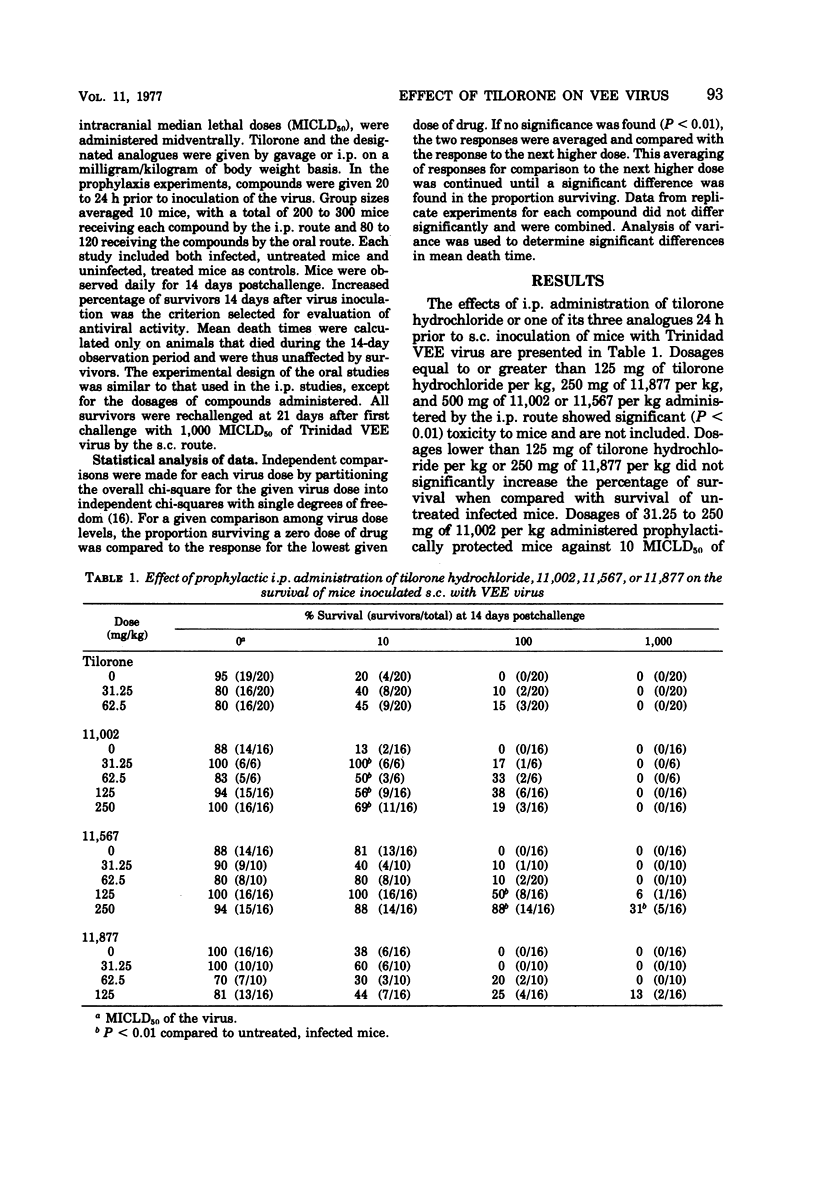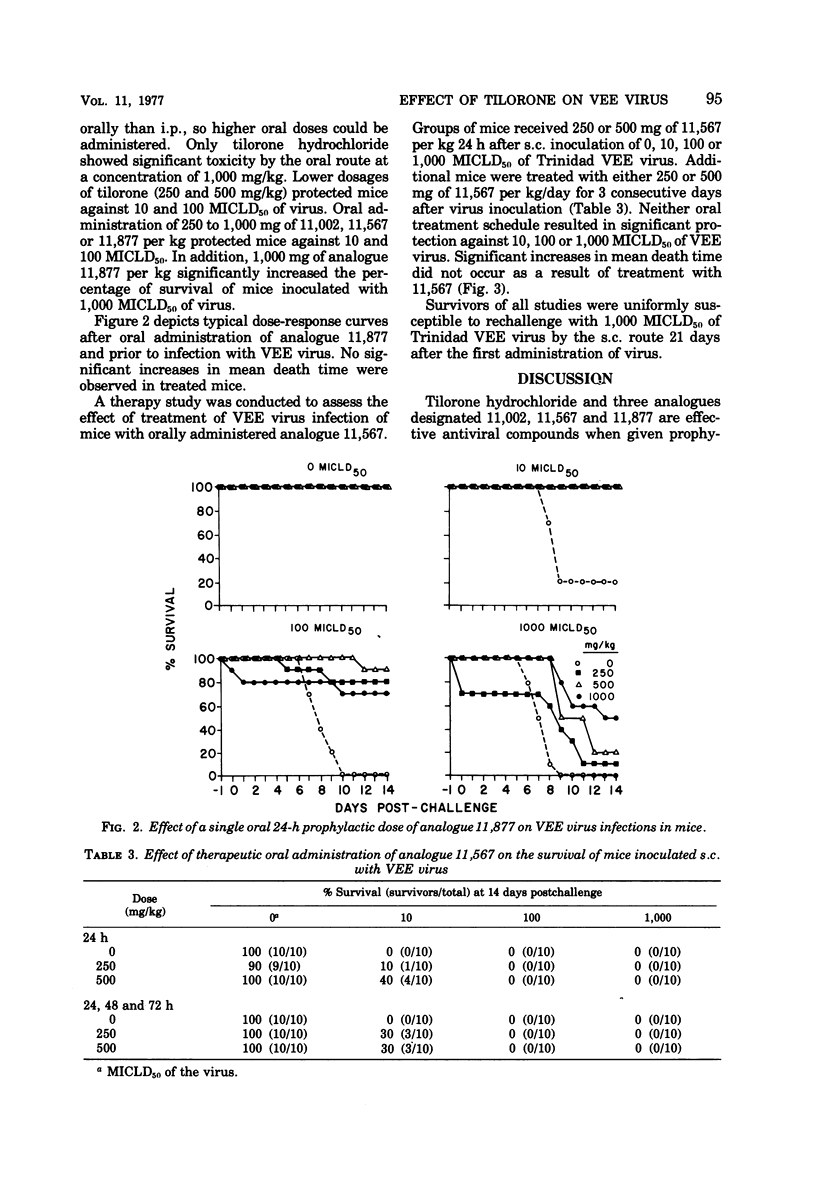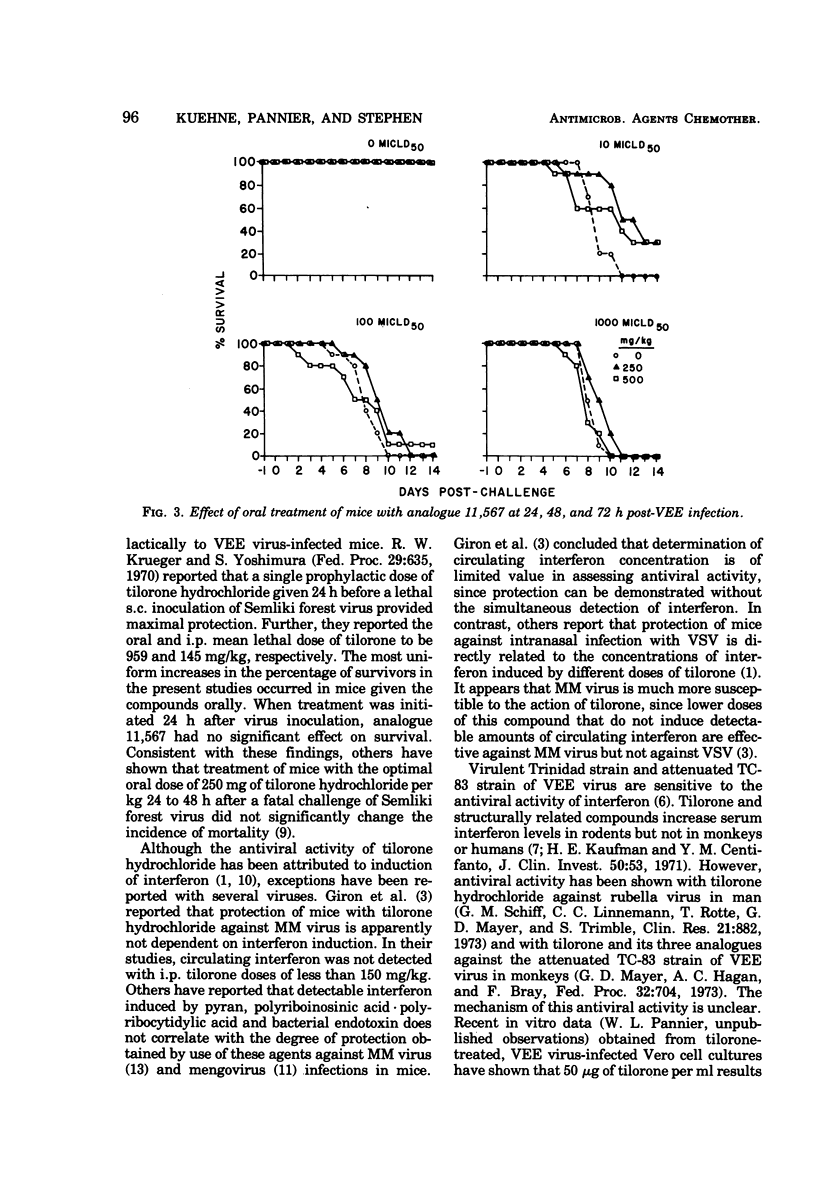Abstract
The antiviral activity of tilorone hydrochloride and three of its analogues (11,002, 11,567, and 11,877) was assessed by oral and intraperitoneal (i.p.) administration to Venezuelan equine encephalitis (VEE) virus-infected mice. Significant increases in the percentage of survival (P < 0.01) were apparent after oral administration of tilorone and analogue 11,877 at dosages of 250 and 500 mg/kg. Neither tilorone nor 11,877 increased percentage of survival when dosages of 31.25 to 500 mg/kg were given by the i.p. route. Orally administered analogue 11,002 was effective against 100 mouse intracranial median lethal doses (MICLD50) of VEE virus at doses at 250 to 1,000 mg/kg; doses of 31.25 to 250 mg/kg given i.p. were effective against 10 MICLD50. Oral dosages of 250 to 1,000 mg of analogue 11,567 per kg were active against 100 MICLD50 of virus. By the i.p. route, 250 mg of 11,567 per kg protected mice against 1,000 MICLD50, and a dose of 125 mg/kg protected against 100 MICLD50. Oral treatment of VEE infection with analogue 11,567 24 h after subcutaneous inoculation of VEE virus resulted in no significant increase in the percentage of survivors. All survivors of these studies were susceptible to rechallenge 21 days after the first inoculation of virus.
Full text
PDF





Selected References
These references are in PubMed. This may not be the complete list of references from this article.
- De Clercq E., Merigan T. C. Bis-DEAE-fluorenone: mechanism of antiviral protection and stimulation of interferon production in the mouse. J Infect Dis. 1971 Feb;123(2):190–199. doi: 10.1093/infdis/123.2.190. [DOI] [PubMed] [Google Scholar]
- Desmyter J., Melnick J. L., Rawls W. E. Defectiveness of interferon production and of rubella virus interference in a line of African green monkey kidney cells (Vero). J Virol. 1968 Oct;2(10):955–961. doi: 10.1128/jvi.2.10.955-961.1968. [DOI] [PMC free article] [PubMed] [Google Scholar]
- Giron D. J., Schmidt J. P., Pindak F. F. Tilorone hydrochloride: lack of correlation between interferon induction and viral protection. Antimicrob Agents Chemother. 1972 Jan;1(1):78–79. doi: 10.1128/aac.1.1.78. [DOI] [PMC free article] [PubMed] [Google Scholar]
- Hilleman M. R. Double-stranded RNAs (poly I:C) in the prevention of viral infections. Arch Intern Med. 1970 Jul;126(1):109–124. [PubMed] [Google Scholar]
- Hilleman M. R. Prospects for the use of double-stranded ribonucleic acid (poly I:C) inducers in man. J Infect Dis. 1970 Feb;121(2):196–211. doi: 10.1093/infdis/121.2.196. [DOI] [PubMed] [Google Scholar]
- Jordan G. W. Interferon sensitivity of Venezuelan equine encephalomyelitis virus. Infect Immun. 1973 Jun;7(6):911–917. doi: 10.1128/iai.7.6.911-917.1973. [DOI] [PMC free article] [PubMed] [Google Scholar]
- Kaufman H. E., Centifanto Y. M., Ellison E. D., Brown D. C. Tilorone hydrochloride: human toxicity and interferon stimulation. Proc Soc Exp Biol Med. 1971 May;137(1):357–360. doi: 10.3181/00379727-137-35576. [DOI] [PubMed] [Google Scholar]
- Krueger R. E., Mayer G. D. Tilorone hydrochloride: an orally active antiviral agent. Science. 1970 Sep 18;169(3951):1213–1214. doi: 10.1126/science.169.3951.1213. [DOI] [PubMed] [Google Scholar]
- Mayer G. D., Krueger R. F. Tilorone hydrochloride: mode of action. Science. 1970 Sep 18;169(3951):1214–1215. doi: 10.1126/science.169.3951.1214. [DOI] [PubMed] [Google Scholar]
- Merigan T. C., Finkelstein M. S. Interferon-stimulating and in vivo antiviral effects of various synthetic anionic polymers. Virology. 1968 Jul;35(3):363–374. doi: 10.1016/0042-6822(68)90215-8. [DOI] [PubMed] [Google Scholar]
- Pindak F. F., Schmidt J. P., Giron D. J., Allen P. T. Interferon levels and resistance to viral infection associated with selected interferon inducers. Proc Soc Exp Biol Med. 1971 Oct;138(1):317–321. doi: 10.3181/00379727-138-35887. [DOI] [PubMed] [Google Scholar]
- Randall R., Mills J. W. FATAL ENCEPHALITIS IN MAN DUE TO THE VENEZUELAN VIRUS OF EQUINE ENCEPHALOMYELITIS IN TRINIDAD. Science. 1944 Mar 17;99(2568):225–226. doi: 10.1126/science.99.2568.225. [DOI] [PubMed] [Google Scholar]
- Schafer T. W., Lockart R. Z., Jr Interferon required for viral resistance induced by poly I.poly C. Nature. 1970 May 2;226(5244):449–450. doi: 10.1038/226449a0. [DOI] [PubMed] [Google Scholar]


